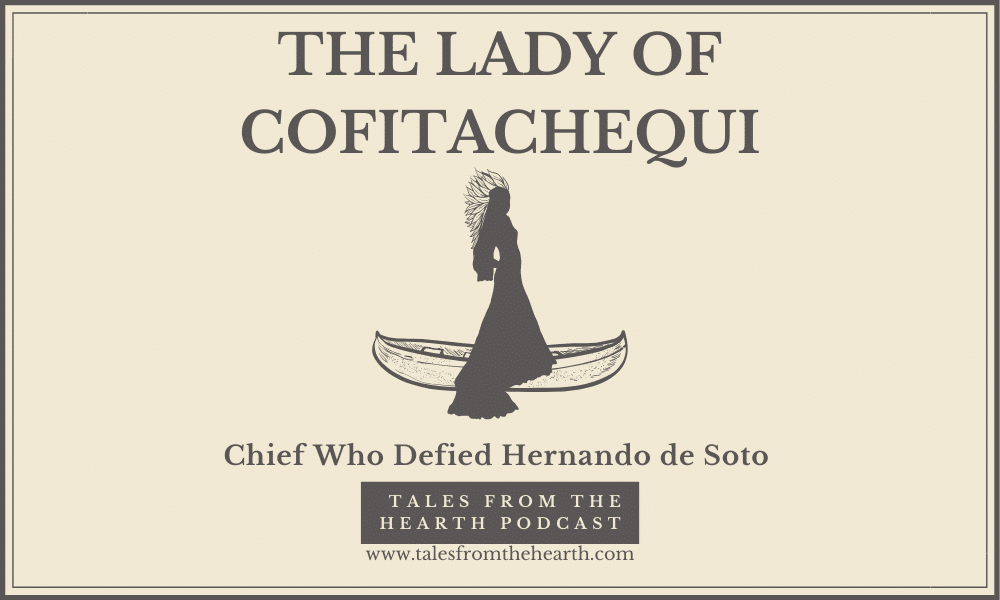The Lady Chief of Cofitachequi
Did you hear about the female chief of the wealthy kingdom of Cofitachequi located in South Carolina? She defied Spanish conquistador Hernando de Soto as he tried to rip apart her kingdom in search of riches. Join us for today’s episode on the Lady Chief of Cofitachequi.
Let’s get cracklin’, shall we?
**********
No one seems to know the name of the Lady of Cofitachequi, and little is known of her reign.
The center of the lost kingdom of Cofitachequi is located near present-day Camden, South Carolina, just about 35 miles northeast of Columbia, South Carolina. A branch of the Mississippi Native Americans, the kingdom stretched from the mountains of South Carolina east—until the coast. Its people spoke Muskogeean, Catawban, and Cherokee languages. The kingdom rose to power around the year 1300, but by circa 1700 AD, the kingdom and all its people had vanished.
Sources for today’s story are: Many! As always, refer to the episode show notes at www.talesfromthehearth.com that’s www.talesfromthehearth.com. You can find all of the links to the resources for today’s episode on our website.
You can view many photos and links to information about Cofitachequi on our Pinterest board located at https://www.pinterest.com/TalesfromtheHearth/cofitachequi/.
A primary resource is a great book about women entitled UPDATED: South Carolina Women: Their Lives and Times, Volume 1 by Multiple Editors and Contributors.
The One Takeaway I hope you get from this story is: Be careful before choosing to placate others.
Now, I hope you enjoy the story about the Lady Chief of Cofitachequi.
***********
Mississipian Native Americans lived in the Southeast from ~1000 to ~1700 AD and consolidated power into larger chiefdoms instead of smaller family units. This allowed for greater interdependence, trade, and surplus food.
Mississipians believed that their chiefs were descended from the sun, and built temples on top of tall earthen mounds to be closer to it. Their chiefs were almost always exclusively men, but they claimed lineage through their mothers—so chiefdom usually passed from uncle to nephew. A maternal society, strong women held positions of power—overseeing households, trade, farming, and other important issues.
Although it was not uncommon to see women in powerful roles, rarely were they made chief. No one knows why or how the Lady of Cofitachequi achieved the chiefdom. It could have been due to recent illnesses brought by the Europeans, such as smallpox, measles, flu, typhus, etc., that swept through the kingdom, taking all male heirs. No one knew for sure what happened.
In 1540 the gold-hungry Spanish explorer Hernando de Soto and his men tore through the present-day southeastern United States in search of gold and riches, ransacking and terrorizing local natives. In Florida, he heard rumors of a mighty, rich, and powerful kingdom—ruled by a woman. The expedition almost starved making its way north to try to find this fabled kingdom—torturing people along the way to learn its exact location. Finally, on May 1, 1540, the de Soto expedition entered Cofitachequi (which means “The Mulberry Site”) and were told to await the arrival of the Cofitachequi’s lady chief.
The Lady of Cofitachequi made her entrance to the water carried by her people on a litter wrapped with fine white cloth. They placed her into a cushioned canoe covered by a sunshade at the water’s edge to talk with de Soto through a translator.
She was described as a confident and dazzling woman whose show of power impressed the Spanish. She greeted the conquistadors as visitors, offering them gifts of freshwater pearls, animal skins, salt, blankets, and food—temporarily placating their thirst for gold. Chances are highly likely that she knew of de Soto’s reign of terror throughout the Southeast—and that he had the military supplies and might of 600 men to destroy Cofitachequi if he so wished.
The Lady of Cofitachequi continued her strategy of placating the Spanish conquistadors, allowing them to enter into the sacred temples her people had built on top of earthen mounds. The temples held the remains of previous chiefs, as well as many precious objects. According to the story, de Soto’s men seized two hundred pounds of pearls from one temple alone. In response to this insult, the Lady of Cofitachequi was said to have commented that that was very little compared to the vast riches of her city of Talimeco.
The Spaniards were complimentary of the people of Cofitachequi and saw them as intelligent, well-fed and clothed, beautiful, and wealthy. Cofitachequi had an organized society of farming, government, and social activities. The Spaniards thought that the land was so rich in soil, fruits, and game that many of them talked of settling there. For reference (this was 1540), the Spanish settlement of St. Augustine, Florida, and Santa Elena (near Port Royal, South Carolina) wouldn’t be established for another 25+ years, in 1565 and 1566, respectively.
The Spaniards also found that the Cofitachequis possessed beads, rosaries, and Spanish axes from the abandoned colony of San Miguel de Gauldape in Georgia in 1526. De Soto and his men continued to stay in Cofitachequi, eating and consuming much of its resources and looking for more riches. The conquistadores continued to demand more and more of the Lady and her people.
Finally, the Lady of Cofitachequi stopped placating the Spaniards, and it was said that she and her people disappeared, hoping to force de Soto and his hungry men to seek resources elsewhere. The conquistadors pillaged the countryside for food and slaves, and ransacked the riches of the sacred temple at Talimeco. It was said that the Spanish exploiters consumed all of their appropriated food after only ten days, and then they wanted to travel west to find gold in the Appalachian mountains. De Soto ordered his men to find the Lady of Cofitachequi so she could order her people to provide food for them along their journey west.
The Lady was found and forced, along with her servants, to accompany de Soto’s trek. She ordered her people to provide food for the marching Spaniards, but as they approached enemy territory, the Lady developed a plan for escape. She told her captors that she needed “to attend to her necessities,” and escaped along with many of her servants and other enslaved members of the expedition. One man returned after initially escaping and told the story that the Lady had taken a lover from the enslaved members, and it was he who had helped her to escape back to her kingdom.
It’s not documented whatever happened to the Lady of Cofitachequi. Perhaps she did escape with a lover, returned to rule her kingdom, and had a family. Maybe she escaped and never returned to her lands—but continued on to find her own adventure.
What we do know is that Cofitachequi existed and was relatively well off until 1700, when the population of the kingdom was decimated by disease and vanished entirely.
What are your thoughts? What would you have done when faced with powerful, gold-hungry conquistadors? It seems as though the chiefs tried war and almost everything else against de Soto. Would you have realized that placation wouldn’t work, and have tried to unite with your enemies against this common enemy? It seemed as though many of the native chiefs kept sending de Soto to other chiefdoms, rather than allying to attack the group of 600 plus adversaries. Perhaps they should have tried to move and stay ahead of de Soto, burning their own food and shelter and leaving the Spaniards to starve? That strategy worked for many natives, resulting in abandoned colonies and attempts at settlement. I guess we’ll never know.
**********
That’s it for today! I hope you enjoyed today’s story about the Lady Chief of Cofitachequi.


